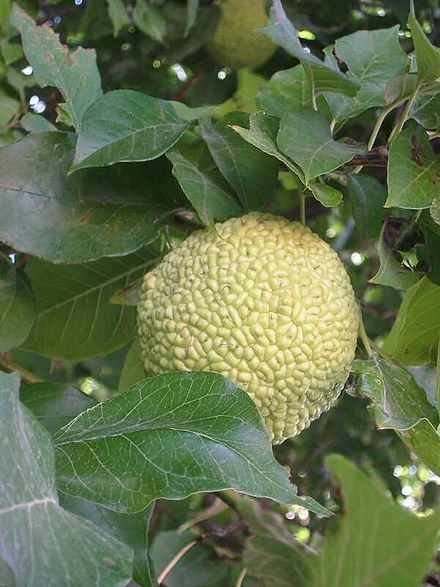7 Amazing Things To Know About Osage Orange

The Osage Orange tree, scientifically known as Maclura pomifera, is a captivating species native to North America that continues to fascinate individuals with its unique characteristics and diverse uses. Despite its name, Osage Orange is not related to the citrus fruit family; instead, it belongs to the mulberry family. This remarkable tree holds historical significance, possesses a distinctive appearance, and offers versatile wood, making it a subject of intrigue and admiration. In this article, we will delve into seven amazing things to know about Osage Orange.
Firstly, we will explore the historical importance of this tree, particularly among Native American tribes like the Osage, who utilized its wood for crafting bows. We will then delve into the tree's unique appearance, characterized by thorny branches, glossy leaves, and the intriguing hedge apples or monkey balls it produces. The versatile wood of Osage Orange will also be highlighted, showcasing its strength, durability, and various applications.
Additionally, we will examine the environmental benefits of Osage Orange trees, including their shade-providing capabilities and ability to deter grazing animals. We will touch upon the traditional medicinal uses of different parts of the tree and the ecological role it plays in supporting bird species and small mammals. By exploring these seven amazing aspects of Osage Orange, readers will gain a deeper appreciation for this extraordinary tree and its contributions to history, nature, and human endeavors.
7 Amazing Things to Know About Osage Orange
- Historical Significance
- Unique Appearance
- Fascinating Fruit
- Versatile Wood
- Environmental Benefits
- Medicinal Uses
- Ecological Role
1. Historical Significance
The Osage Orange tree has a rich historical significance. Native to the central and southern regions of the United States, it played a vital role in the lives of Native American tribes, particularly the Osage tribe from which it derives its name. The Osage tribe utilized the wood from this tree for crafting bows, making it one of the most essential tools for hunting and warfare. The strength, flexibility, and durability of Osage Orange wood made it highly valued among the Native American tribes.
2. Unique Appearance
Osage Orange trees possess a distinct appearance that sets them apart from other trees. They typically grow up to a height of 30-40 feet, with a spreading canopy that provides ample shade. The tree's branches are armed with thorny spikes, which act as a natural defense mechanism against animals. Its dense foliage comprises glossy dark green leaves that turn vibrant yellow in the autumn, adding a touch of beauty to the landscape.
3. Fascinating Fruit
READ ALSO » Top 10 Foods That Have Vitamin C Than Orange
The fruit of the Osage Orange tree is a fascinating aspect of this species. Known as hedge apples or monkey balls, these fruits are roughly the size of a grapefruit and have a bumpy, bright green exterior. Despite their unusual appearance, hedge apples are not edible for humans. However, they do serve a purpose. Some people believe that placing hedge apples in basements or other areas can repel insects such as spiders. While scientific evidence for this claim is limited, the belief persists.
4. Versatile Wood
Osage Orange wood possesses exceptional qualities that make it highly versatile and sought after. The heartwood of the tree exhibits a vibrant golden-yellow color that darkens with age, creating beautiful and durable furniture, flooring, and decorative items. Due to its high density, Osage Orange wood is incredibly strong and rot-resistant, making it ideal for fence posts, tool handles, and even archery bows. In fact, it is considered one of the best natural materials for making longbows.
5. Environmental Benefits
Osage Orange trees offer several environmental benefits. Their dense foliage provides shade, reducing the energy required for cooling buildings during hot summer months. Additionally, the thorny branches act as a deterrent to grazing animals, protecting other plants in the area. Osage Orange trees are also known to tolerate drought and poor soil conditions, making them a hardy and adaptable species.
6. Medicinal Uses
Traditionally, various parts of the Osage Orange tree have been used for medicinal purposes. Native American tribes used the bark, roots, and fruit to create herbal remedies. The fruit was believed to have antifungal and insect-repelling properties, while the bark and roots were used to treat ailments such as fevers, rheumatism, and digestive disorders. It's important to note that these traditional uses are not supported by modern scientific evidence, and caution should be exercised when using plant-based remedies.
7. Ecological Role
Osage Orange trees play a significant ecological role in their native habitat. The dense foliage and thorny branches provide shelter and protection for various bird species, including the Northern Bobwhite and Wild Turkey. The tree's fruit is consumed by small mammals, such as squirrels and raccoons, contributing to their dietary needs. Furthermore, the deep-reaching roots of Osage Orange trees help stabilize soil and prevent erosion, making them valuable in land restoration and reclamation projects.
In Conclusion, Osage Orange, with its historical significance, unique appearance, versatile wood, and ecological benefits, is a truly remarkable tree. From its importance to Native American tribes to its modern-day uses in carpentry and landscaping, this tree continues to captivate and intrigue. Whether you appreciate its beauty, utilize its wood, or marvel at its ecological contributions, Osage Orange remains an enduring symbol of nature's wonders.
